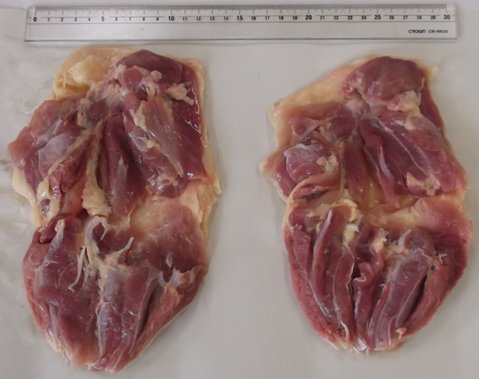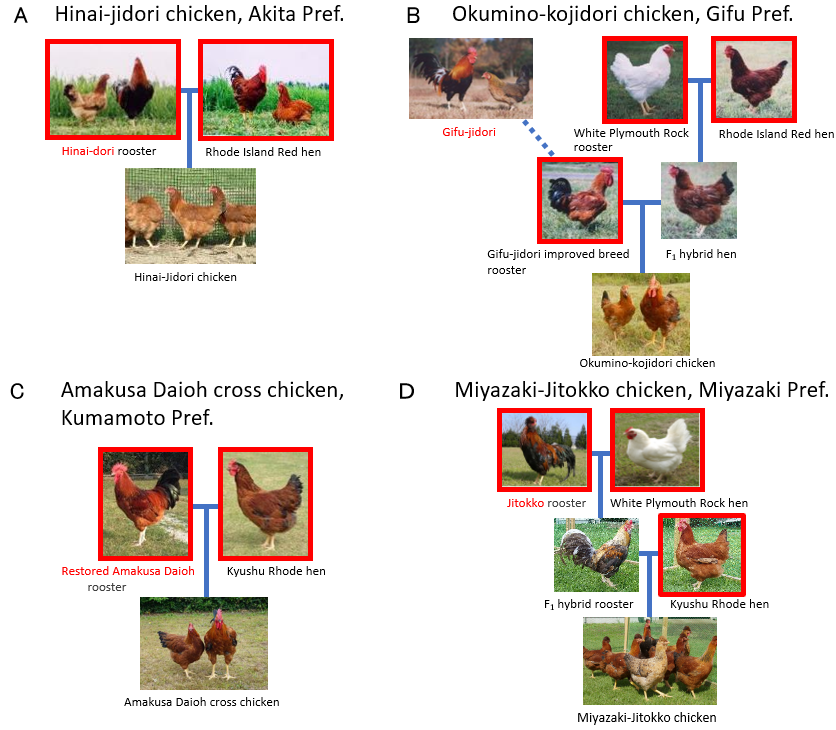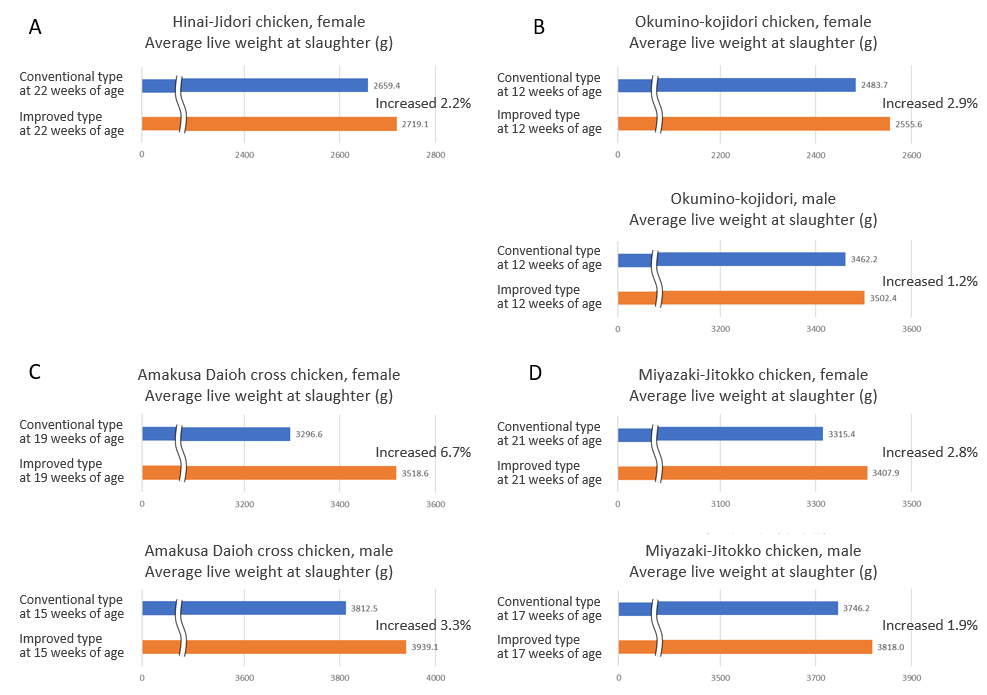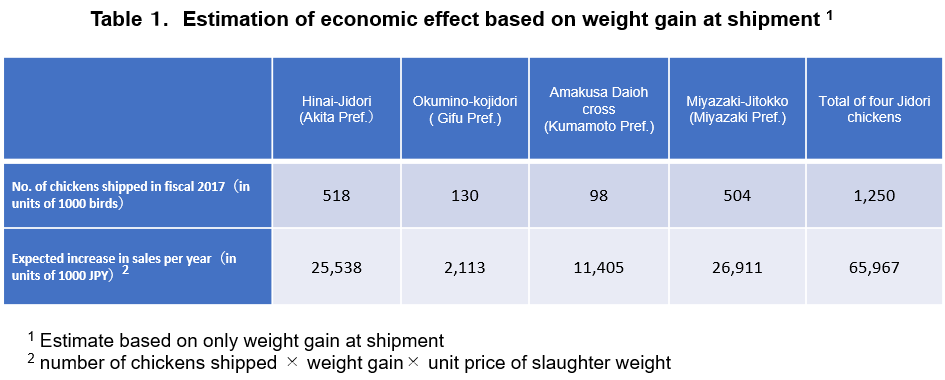The Institute of Livestock and Grassland Science, NARO (NILGS-NARO) has succeeded in improving the growth performance in four Japanese slow-growing brand chickens, i.e., Hinai-jidori, Okumino-kojidori, Amakusa Daioh cross, and Miyazaki-jitokko, by molecular marker-assisted selection, in collaboration with the Akita Prefectural Livestock Experimental Station, the Gifu Prefectural Livestock Research Institute, the Kumamoto Prefectural Agricultural Research Center, and the Miyazaki Prefectural Livestock Research Institute. It is expected to be applicable for improving growth performance of the other slow-growing chickens.
Overview
In Japan, fast-growing broilers constitute more than 90% of poultry meat production. However, some native breeds are being used to "Jidori" brand chickens that are defined in the Japanese Agricultural Standard (JAS). Jidori still occupies a certain share in the Japanese market, because Japanese consumers recognize and appreciate its rich taste and flavor. The JAS defines Jidori as cross-bred chickens with over 50% of native-bred hereditary and thus most Jidori brand chickens are bred by crossing indigenous Japanese breeds with highly selected lines that exhibit rapid growth and/or high egg productivity. A practical concern for Jidori producers is to shorten the rearing period and/or increase the slaughter live weight, an improvement in growth traits is warranted.
In 2012, NILGS-NARO, in collaboration with the Akita Prefectural Livestock Experimental Station, reported a significant association between a single nucleotide polymorphism (SNP; AB604331, g.420 C>A) in the 5'-untranslated region of the cholecystokinin type A receptor gene (CCKAR) and growth traits in the Hinai-dori breed, which is a paternal stock line of the Hinai-jidori chickens. Following this achievement, NILGS-NARO decided to verify whether the g.420 C>A SNP in CCKAR can be used as a marker to improve growth traits of Jidori brand chickens commercially available in the Japanese market.
In the present study, all parent stock lines of Hinai-jidori (Akita Prefecture), Okumino-kojidori (Gifu Prefecture), Amakusa Daioh cross (Kumamoto Prefecture), and Miyazaki-jitokko (Miyazaki Prefecture) chickens shown in Fig. 1 were selected by using A-allele of the SNP as a molecular marker and resultantly A-allele fixed lines were developed. From the A-allele fixed lines, four Jidori brand chickens were practically produced as their improved types. Then, their growth performance were compared with the conventional ones. Consequently, significant improvement of the slaughter live weight was observed in the Jidori brand chickens (Fig. 2).
Prefectural research institutes and experimental stations of the four prefectures above mentioned will supply the improved parent stock lines to hatcheries from FY2019. This achievement is expected to contribute in increasing the income of the four Jidori producers in the four prefectures. If all chickens are replaced by the improved types, it is expected that an annual producer income will increase to about 66 million yen (Table 1). Moreover, this achievement will lead in improving the growth potential of the other slow-growing chickens not only in Japan, but also worldwide.
Publications
- Rikimaru K, Komatsu M, Suzuki K, Uemoto Y, Takeda H, Takahashi H (2012). Association between cholecystokinin type A receptor haplotypes and growth traits in Japanese Hinai-dori crossbred chickens. Molecular Biology Reports 39: 4479-4484. 2012. https://doi.org/10.1007/s11033-011-1237-9
- Rikimaru K, Takeda H, Uemoto Y, Komatsu M, Takahashi Di, Suzuki K and Takahashi H (2013). Effect of a single-nucleotide polymorphism in the cholecystokinin type A receptor gene on growth traits in the Hinai-dori chicken breed. The Journal of Poultry Science 50: 206-211 https://doi.org/10.2141/jpsa.0120130
- Takahashi H, Katayama M, Michishita K, Yamashita H (2018). The A allele of the cholecystokinin type A receptor gene g.420 C > A polymorphism improves growth traits in Amakusa Daioh Cross chicken. The Journal of Poultry Science https://doi.org/10.2141/jpsa.0180065
- Horinouchi S, Nakayama H, Takahashi H (2018). Effect of a single nucleotide polymorphism in the cholecystokinin type A receptor gene on growth traits of the Miyazaki Jitokko chicken. The Journal of Poultry Science https://doi.org/10.2141/jpsa.0180077
Reference Information

Thigh meat of Amakusa Daioh cross female chicken slaughtered at 19 weeks of age old.
Before (right) and after (left) improvement.

Fig.1 Ways in which "Jidori" chickens are produced from 4 prefectures
Hinai-jidori, Okumino-kojidori, Amakusa Daioh cross, and Miyazaki-jitokko are Jidori brand chickens. They are produced utilizing breeds (Hinai-dori, Gifu-jidori, restored Amakusa Daioh, Jitokko breeds) native of Akita, Gifu, Kumamoto, and Miyazaki Prefectures, respectively. In this study, the parent stock lines enclosed in red frames were selected by an SNP marker (AB604331: g.420 C > A) in the cholecystokinin A receptor gene.

Fig. 2 . Comparison of average slaughter weight with and without gene selection
Estimated slaughter weight was calculated correcting the variety of repeats. In the case of Hinai-jidori, only females are commercially available, so male data is not included. In all four Jidori chickens, significant increase in slaughter weight was observed by fixation of A-allele in the SNP site. The scale interval is 200g. Percentage of improved slaughter weight in comparison with that of conventional type was shown in right side in each graph.





